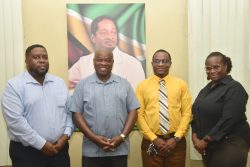Dear Editor,
I refer to the caption contained at page 1 and the article at pages 3 and 5 of the Guyana Chronicle of January 19 under the headings, ‘Singh strikes’ and ‘Singh strikes twice’, and request that you publish this correspondence so the public would not be misled on the Bharrat Jagdeo, Babu John alleged racial statement case in the Court of Appeal.
First of all, the article states that the original application was “put before Justice William Ramlal”, implying that Mr Jagdeo went ‘judge shopping’. In reality the application was filed by me in the High Court Registry in Berbice on June 26, 2015 primarily because I practise mainly in Berbice. There was nothing in the rules of court or in practice to deny a lawyer the right to file such an application in the county where he normally has his practice.
At the time of the filing of the application for the order of prohibition Mr Justice William Ramlal was the presiding civil judge in Berbice, sitting in Bail Court/Motion Court. Lawyers in Berbice do not and cannot choose judges because in Berbice there is a ‘civil’ judge and a ‘criminal’ judge. Applications for prerogative writs are made to the civil judge and not the criminal judge. Therefore of necessity, the matter went before Justice Ramlal who granted the order nisi ordering Magistrate Artiga, by whom the charge was being considered, to show cause why that order nisi should not be made absolute. The Attorney General was never a party to those proceedings. Subsequently, Ms Artiga filed an affidavit purporting to show cause why the order nisi should not be made absolute. That affidavit was drawn by the Deputy State Solicitor Ms Prithma Kissoon. It stated at paragraph 24 that the Attorney General was counsel for Ms Artiga.
On December 11, 2015 Justice Navindra Singh, after written submissions by me and Ms Kissoon, made the order nisi absolute; that is, that the Magistrate must not take any further steps in the matter. Up till then only Bharrat Jagdeo and Magistrate Artiga were parties to the proceedings.
On January 18, 2016 the Attorney General, although not being a party to the proceedings, filed an appeal to the Court of Appeal against Justice Singh’s order. The appeal was signed by the Solicitor General. That amounted to an abuse of the court’s process as the Attorney General, not being a party, had no right to appeal.
On September 13, 2016 I, on behalf of Bharrat Jagdeo, filed a motion in the Court of Appeal seeking an order to strike out or dismiss the appeal on the ground that it was an abuse of the court’s process.
Since 2003 (see 67 WIR- Attorney General v Jardim) the Court of Appeal, consisting of Bernard, Chancellor; Kissoon JA; and La Bennett, additional judge, had ruled in identical circumstances, that the Attorney General not being a party to the originating proceedings, had no right to file an appeal. The court dismissed that appeal.
Normally a motion to strike out is heard promptly by the Court of Appeal. However, shortly after September 13, 2016 the Court of Appeal went on statutory vacation. On its resumption the court fixed the motion to strike out for December 19, 2016. On that date Ms Kissoon laid over written submissions. I laid over my written submissions on December 29, 2016. At paragraph 2 of her submissions Ms Kissoon quite properly conceded that the Attorney General was never a party to the proceedings before Justice Singh.
Ms Kissoon in her written submissions and orally made an application to the court for an amendment to the Notice of Appeal to remove the name of the Attorney General as appellant and substitute Ms Artiga as the appellant. Of course I objected to such an application and argued, on the authority of GTM v Chandroutie 1991-93 GLR 175, that the Notice of Appeal being a nullity, was incapable of being amended. I also argued that Ms Kissoon had no mandate from Ms Aritga to make such an application and in any event the amendment would result in an appeal being filed over one year after the decision of Justice Singh without any grounds to satisfy Order 2 rule (3) (4 and (5) of the Rules of the Court of Appeal.
On January 9, 2017 the Attorney General appeared in the Court of Appeal in person and was granted leave at his request, to file further written submissions within 5 days. The matter was then fixed for January 18, 2017 for ruling.
On January 18, the court delivered its decision dismissing the appeal as an abuse to the process of the court, a jurisdiction that the court undoubtedly had.
Up to January 18, 2017 the Attorney General had not filed any additional submissions. He did not attend court on that date. Ms Stewart from the Attorney General’s office attended and held for Ms Kissoon. That was the first time that Ms Stewart was placed on record.
The article in the Guyana Chronicle gives the impression that the court was constituted by the Chancellor alone. That was a deliberate attempt to mislead. The court was constituted by the Chancellor, Justice of Appeal BS Roy and additional judge Dawn Gregory. It was so constituted on all the occasions. The ruling was read by the Chancellor but it was the ruling of the court, that is by all three judges.
It is indeed strange and unfair for blame to be laid, as the article does, at the feet of the Chancellor. The filing of the appeal with the Attorney General as appellant was a colossal blunder on the part of the law officers of the state, and that blunder should not be shifted onto the court or any member of the court.
It is an indictment on the law officers of the state that although the motion to strike out was filed and served on the Attorney General since September 13, 2016, no proper application was made for an extension of time to file an appeal by them on behalf of Ms Artiga.
Yours faithfully,
M Bacchus
Attorney-at-law








